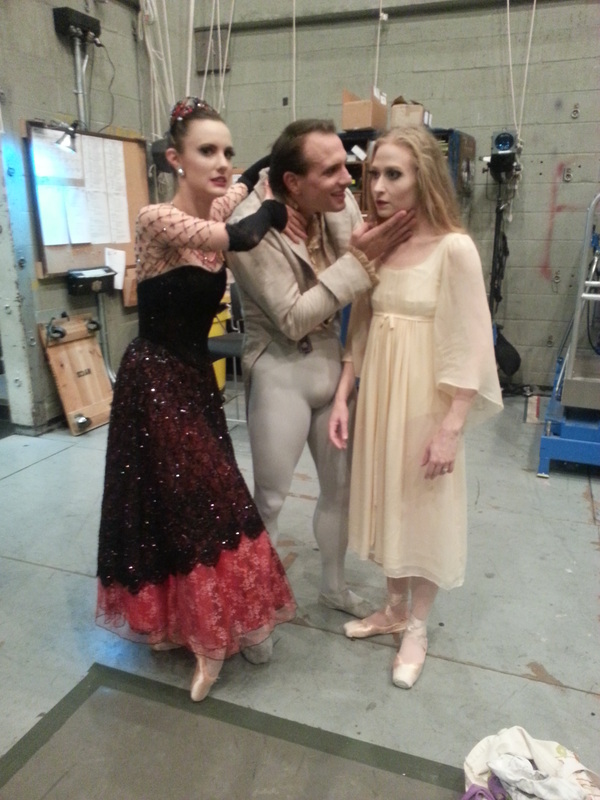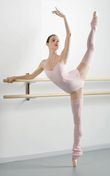Suddenly the Poet notices candlelight descending from the upper story of the mansion and a mysterious somnambulist appears, clad in a nightgown and holding a flickering taper. She does not appear to see him or awaken, but they dance together and he falls in love with her. The Coquette, who has escaped the dinner to look for him, stumbles onto the scene just in time to
Now, there are a lot of holes in this scenario and I have a lot of questions about it. Are the Poet and the Coquette already lovers? Likewise, does the Baron already know him? Why does the Baron leave the Poet and the Coquette alone for so long? Is the Sleepwalker a ghost or a real person? Many allege that she is the Baron’s wife: is this Balanchine’s take Jane Eyre with the madwoman in the attic? Does the Sleepwalker reciprocate the Poet’s love or is she more symbolic: perhaps Death luring him away from the world of the living? Does the Coquette already know about the Sleepwalker figure or is she confused too? What exactly are the Poet and the Sleepwalker doing offstage when the Coquette peeks at them? Can the other guests see the Sleepwalker when she reenters after the Poet’s death? Where does she take him? Where did the Baron go? I could go on, but there aren’t clear-cut answers to any of this so it would be futile. Although this is ostensibly a story ballet, it is all about mood and insinuation rather than realistic detail. The characters don’t even have proper names, everyone is an allegorical type.
From the moment the overture begins the eerie, foreboding atmosphere of the ballet is established. The curtain rises on a fifteen count musical phrase—an uncomfortably uneven and unusual measure. In the ballroom dances there are lots of passages of five and nine in the score which heightens the ambient tension of the piece. As the curtain goes up the opening tableau is frozen, but quickly comes to life as the Baron and the Coquette gossip and preen in the center of their circle of guests. The dark lighting and the grotesque, avian masks of the guests make for a glauque scene—I always think of Stanley Kubrick’s Eyes Wide Shut. This is not the exalted ballroom of Balanchine’s Liebeslieder Walzer or Vienna Waltzes; this ballroom is menacing and evil like in La Valse. The game of blind man’s bluff (a notorious symbol of sexual depravity in the Victorian Era) that the Coquette and her guests force upon the Poet is telling: these are not innocent people; this is not an innocent place. The three divertissements have sinister undertones as well. The first, Pastorale quartet evokes rococo ideas about country life and Marie Antoinette’s elitist Petit Hameau. The “exotic” pas de deux which follows was originally conceived as a Moorish Dance and performed in blackface (thank god that practice was dropped when the ballet was revived in 1960!!) and contains odd partnering by the neck, stylized bent legs, and Kama Sutra-like intertwined limbs. The Harlequin’s solo is even weirder—he is apparently being plagued by lumbar problems while also being hounded by some threat offstage. What a combination! Who or what is after him is never revealed even as he jumps headlong into the wings at the end of his prankish dance.
After the divertissements comes the pas de deux for the Poet and the Coquette quickly followed by the pas de deux for the Poet and the Sleepwalker. This juxtaposition is purposeful and illuminating, for the two women could not be more opposite. The music for the Coquette’s pas is steady and pulsing like a heartbeat. She and the Poet often stamp out the music’s rhythms and chug along with the beat. The Sleepwalker’s music has floating, sustained melodies which she matches by skimming across the floor on pointe. The Coquette, in her red and black gown, is all flesh; the Sleepwalker, in her virginal white shift, is all soul. The Coquette’s movements—in the group dances as well as in her pas—are circular, twisted, turning, like a shark circling its prey. The Coquette’s circles—unlike the humanist, circle-of-life affirming rings which close Robbins’ Glass Pieces—hint at her cageyness, her web of deceit. In contrast, the Sleepwalker moves with a linear directness (she reminds me of Pac Man) as she coasts around the stage.
Balanchine creates a sharp divide in movement quality in these two pas de deux too. The Coquette’s partnered lifts rise and fall like waves or human breath—or cresting and ebbing desire. She is rocked to the right and left like a pendulum by the Poet. In a repeated motif she spins away into arabesque only to be dragged backwards by the poet repeatedly. Her choreography is grounded and weighted; many of her steps are done in a deep plié. The poet constantly tries to embrace her and she wriggles out of his grasp, she is never allowed to stand still and alone—a sign of her role as a mistress, of her utter dependency on the men around her. Conversely, the Sleepwalker is fiercely independent, a loner who enters the ballroom only after the ghastly guests have cleared out. To signify that she exists on a higher plane of existence her heels rarely touch the floor—she travels everywhere in gliding bourrée steps. Her movements—like a slow, supported arabesque penché—are calm and prolonged. Instead of trying to wrap her in his arms like he does the Coquette, the Poet arches his back around the Sleepwalker until he lies prostrate on the floor. In his pas with the Coquette the Poet is about greedy acquisition; in his pas with the Sleepwalker he learns humility and supplication.
The spiritual overtones of the Sleepwalker cannot be denied—the candle flame is an obvious reference to her inner light. Women guided by candlelight are often women lit by goodness within in Balanchine ballets, like Frau Stahlbaum in the Nutcracker. With candle in hand she is a literal beacon of maternal love as she searches for her daughter in the darkness during a dulcet violin solo and protectively drapes a blanket over her sleeping child. Similarly, the Sleepwalker’s candle, white dress, and her floating quality prove that she is pure and good, far superior to the morally corrupt denizens of the Baron’s party. It seems that the Poet is drawn to her for this reason. The fact that so much of their partnering is done through the candlestick underscores this spiritual importance (or else it is some strange phallic commentary!). He does not reach for her body, but for her symbolic soul. The Poet is clearly an impressionable man, and although he can play dirty parlor games with the best of them and passionately seduce the Coquette, he never really blends into the masses. His Romantic, pale costume and noble air separate him from the beginning, as of course, does his job description: poet. He is searching for something beyond the hedonistic decadence of his day, and in the Sleepwalker he finds it.
There is a lot more to say about this odd ballet and particularly the Sleepwalker role—I’ll get to it next time.


 RSS Feed
RSS Feed